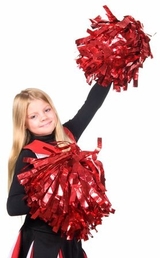
What do the Knicks, Mets and Islanders have in common with the Florida Gators? It's not their history or their sports. Their commonality is two things, or rather, two colors: orange and blue. At their games, you will see orange and blue like a wave of a two-color rainbow throughout the stadium.
But can you copyright an orange and blue color-combo? And if not the color duo, then perhaps each team's logo, mascot stripes, or other patterns connected with the team's uniforms?
The legal question at the heart of apparel copyright is "conceptual separability," which seeks to delineate whether it is possible to separate the specific team-recognized apparel design from the apparel's utilitarian functions. (Apparel is defined as clothing, accessories, baggage, blankets, etc.) If the answer is no, then the apparel copyright could be invalid.
Varsity Brands, Inc. v. Star Athletica, LLC, a Sixth Circuit case, provides an example of a real-world dispute on this issue. Plaintiff Varsity Brands is the world’s largest designer, manufacturer and seller of cheerleading apparel, with five of its many copyrighted cheerleading uniform designs at issue in the suit. Varsity sued Star Athletica for copyright infringement based on the latter’s similarly-designed uniforms. Here, the question was whether the stripes, patterns and colors that are incorporated into the design of a cheerleading uniform can be identified separately and are capable of existing independently of the uniform’s utilitarian aspect. In other words, absent stripes, chevrons, patterns, and color blocks, is a cheerleading uniform still a cheerleading uniform, and its branding is standalone? The Court of Appeals for the Sixth Circuit said yes, thus finding Varsity’s copyrights valid. But the Supreme Court has agreed to review the matter.
The question remains as to how the Supreme Court will define “utility” versus “brand,” a question still open in the fashion industry despite years of lobbying to protect against so-called copyright "knock-offs." By the time you next attend a Knicks, Mets, Islanders or Gators game, the Supreme Court may have already defined what is actually the uniform, and what’s just orange and blue.
But can you copyright an orange and blue color-combo? And if not the color duo, then perhaps each team's logo, mascot stripes, or other patterns connected with the team's uniforms?
The legal question at the heart of apparel copyright is "conceptual separability," which seeks to delineate whether it is possible to separate the specific team-recognized apparel design from the apparel's utilitarian functions. (Apparel is defined as clothing, accessories, baggage, blankets, etc.) If the answer is no, then the apparel copyright could be invalid.
Varsity Brands, Inc. v. Star Athletica, LLC, a Sixth Circuit case, provides an example of a real-world dispute on this issue. Plaintiff Varsity Brands is the world’s largest designer, manufacturer and seller of cheerleading apparel, with five of its many copyrighted cheerleading uniform designs at issue in the suit. Varsity sued Star Athletica for copyright infringement based on the latter’s similarly-designed uniforms. Here, the question was whether the stripes, patterns and colors that are incorporated into the design of a cheerleading uniform can be identified separately and are capable of existing independently of the uniform’s utilitarian aspect. In other words, absent stripes, chevrons, patterns, and color blocks, is a cheerleading uniform still a cheerleading uniform, and its branding is standalone? The Court of Appeals for the Sixth Circuit said yes, thus finding Varsity’s copyrights valid. But the Supreme Court has agreed to review the matter.
The question remains as to how the Supreme Court will define “utility” versus “brand,” a question still open in the fashion industry despite years of lobbying to protect against so-called copyright "knock-offs." By the time you next attend a Knicks, Mets, Islanders or Gators game, the Supreme Court may have already defined what is actually the uniform, and what’s just orange and blue.
Picture Copyright
